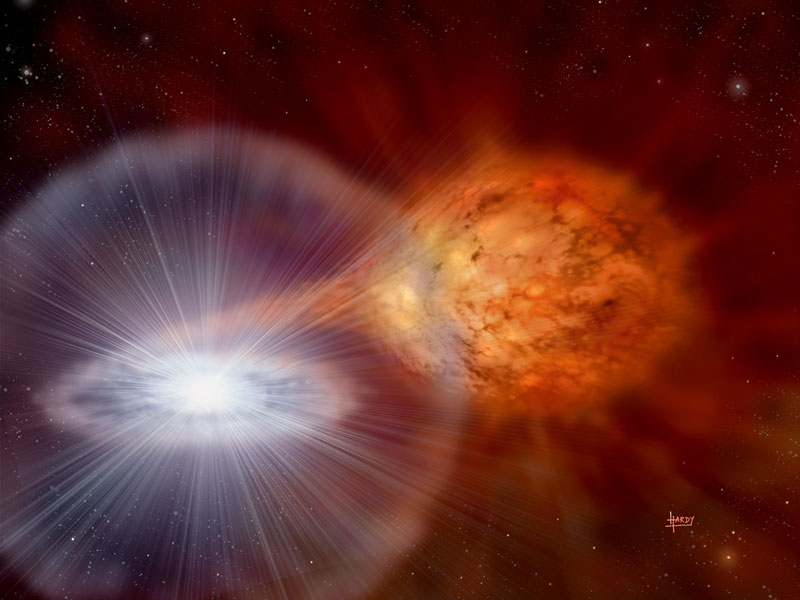Research
Overview
I am interested in stellar structure and evolution-- how stars live and die. In particular, I make computer models of classical and recurrent novae, which are the thermonuclear runways that result from this accretion. I then use these models to predict and explain observations of these events, dozens of which are detected every year.
Novae are a common event in the universe, and their prodigious luminositities, at tens or hundreds of thousands of times greater than that of our sun, make them visible in other galaxies. They are important in the chemical evolution of the galaxies, and they may be an important stepping stone in the path to type Ia supernovae, which are violent explosions that created half of the iron in your body.
Find me on ADS for an exhaustive list of my refereed publications, or look at my CV for a more general summary.

Novae are a common event in the universe, and their prodigious luminositities, at tens or hundreds of thousands of times greater than that of our sun, make them visible in other galaxies. They are important in the chemical evolution of the galaxies, and they may be an important stepping stone in the path to type Ia supernovae, which are violent explosions that created half of the iron in your body.
Find me on ADS for an exhaustive list of my refereed publications, or look at my CV for a more general summary.
First Author Papers
Testing Modules for Experiments in Stellar Astrophysics (MESA)
2023William M. Wolf, Josiah Schwab, R. Farmer, et al.
The Astrophysical Journal Supplement SeriesNonradial Pulsations in Post-outburst Novae
2018William M. Wolf, Richard H. D. Townsend, and Lars Bildsten
The Astrophysical JournalHydrogen Burning on Accreting White Dwarfs: Stability, Recurrent Novae, and the Post-nova Supersoft Phase
2013William M. Wolf, Lars Bildsten, Jared Brooks, et al.
The Astrophysical JournalOther Papers
Modules for Experiments in Stellar Astrophysics (MESA): Time-dependent Convection, Energy Conservation, Automatic Differentiation, and Infrastructure
2023Adam S. Jermyn, Evan B. Bauer, Josiah Schwab, et al.
The Astrophysical Journal Supplement SeriesModules for Experiments in Stellar Astrophysics (MESA): Pulsating Variable Stars, Rotation, Convective Boundaries, and Energy Conservation
2019Bill Paxton, R. Smolec, Josiah Schwab, et al.
The Astrophysical Journal Supplement SeriesThe Impact of White Dwarf Luminosity Profiles on Oscillation Frequencies
2018F. X. Timmes, Richard H. D. Townsend, Evan B. Bauer, et al.
The Astrophysical JournalThe Impact of Nuclear Reaction Rate Uncertainties on the Evolution of Core-collapse Supernova Progenitors
2018C. E. Fields, F. X. Timmes, R. Farmer, et al.
The Astrophysical Journal Supplement SeriesThe volumetric rate of superluminous supernovae at z ∼ 1
2017S. Prajs, M. Sullivan, M. Smith, et al.
Monthly Notices of the Royal Astronomical SocietyRapidly Rising Transients in the Supernova—Superluminous Supernova Gap
2016Iair Arcavi, William M. Wolf, D. Andrew Howell, et al.
The Astrophysical JournalPopulation of post-nova supersoft X-ray sources
2016Monika D. Soraisam, Marat Gilfanov, William M. Wolf, et al.
Monthly Notices of the Royal Astronomical SocietyPhotoionization Heating of Nova Ejecta by the Post-outburst Supersoft Source
2015Timothy Cunningham, William M. Wolf, and Lars Bildsten
The Astrophysical JournalIdentification of the Optical Counterpart of Fermi Black Widow Millisecond Pulsar PSR J1544+4937
2014Sumin Tang, David L. Kaplan, E. Sterl Phinney, et al.
The Astrophysical JournalAn Accreting White Dwarf near the Chandrasekhar Limit in the Andromeda Galaxy
2014Sumin Tang, Lars Bildsten, William M. Wolf, et al.
The Astrophysical Journal